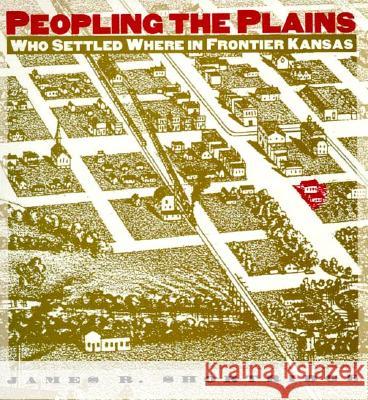Peopling the Plains: Who Settled Where in Frontier Kansas » książka
topmenu
Peopling the Plains: Who Settled Where in Frontier Kansas
ISBN-13: 9780700606979 / Angielski / Twarda / 1995 / 272 str.
In the wake of the turbulent 1850s, Kansas was popularly portrayed as a Yankee stronghold, a "child of Plymouth Rock" where Puritan virtue triumphed over base Southern ways. Perpetuated by a century and a half of historical propaganda, this fictitious notion tenaciously shrouds the real Kansas.
In Peopling the Plains, James R. Shortridge helps set the record straight. Early Yankee settlers did indeed influence the location of major education and governmental facilities, he shows, but they were only one of many regional and ethnic forces that molded the state's complex cultural and economic heritage. Germans and other Europeans established ethnic enclaves in central Kansas and introduced agricultural practices that persist today. Southerners expanded the cattle industry in the southern tier. Midland farmers came in search of cheaper land. Freed slaves sought urban and rural opportunities. Italians and other southern Europeans worked the southeastern mines. And Mexicans helped build the railroads. Chock-full of information and maps constructed from a wealth of census data, this richly annotated atlas illustrates the distribution of settlers from diverse cultural and ethnic origins from across America and around the world. Regional maps, depicting northeastern, southeastern, central, and western counties, are broken down into townships to provide an accurate and detailed picture of the origins of the early immigrants. Beyond mapping the physical settlement patterns--from those of pre-Civil War Yankee and Rebel colonies in the east to the configuration of turn-of-the-century homesteads in the west--Shortridge explores how those patterns were influenced by railroad routes and promotion; land prices and speculation practices; homesteading laws; U.S. and international social, economic, and political conditions; terrain; weather; and pioneer perseverance. He also demonstrates that many legacies of the original settlers have endured and are apparent today in social, political, agricultural, and religious customs throughout the state. "This stimulating and pathbreaking book represents a quantum leap in the geographical study of frontier population origins and their signifacance for later political and cultural development at the state level. Shortridge has crafted a rare and intriguing blend of well-designed maps and thoughtful commentary that will have significance far beyond the specific realm of Kansas history and geography, to which it nevertheless makes a powerful contribution.--Michael P. Conzen, editor of The Making of the American Landscape. "Shortridge continues the great tradition begun by James Malin of weaving regional history out of the state census data, newspaper articles, and various local documents. Both comprehensive and compelling, this book will stand as a classic of Kansas history and should serve as a model for other state demographic histories."--John C. Hudson, author of Making the Corn Belt. "Monumental. A gold mine of information, an absolute required reference for studying the history of Kansas."--C. Robert Haywood, author of Trails South and Victorian West.










